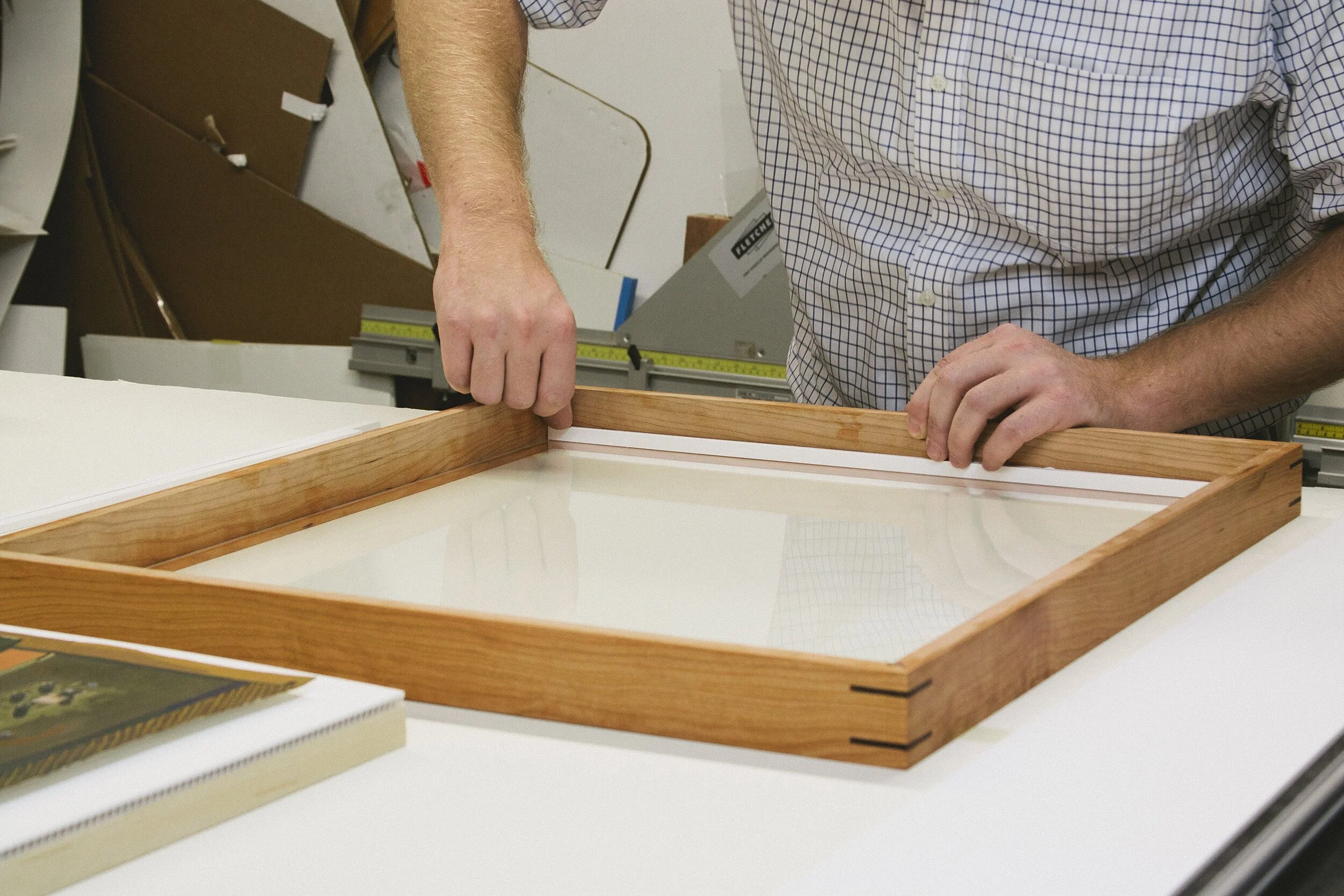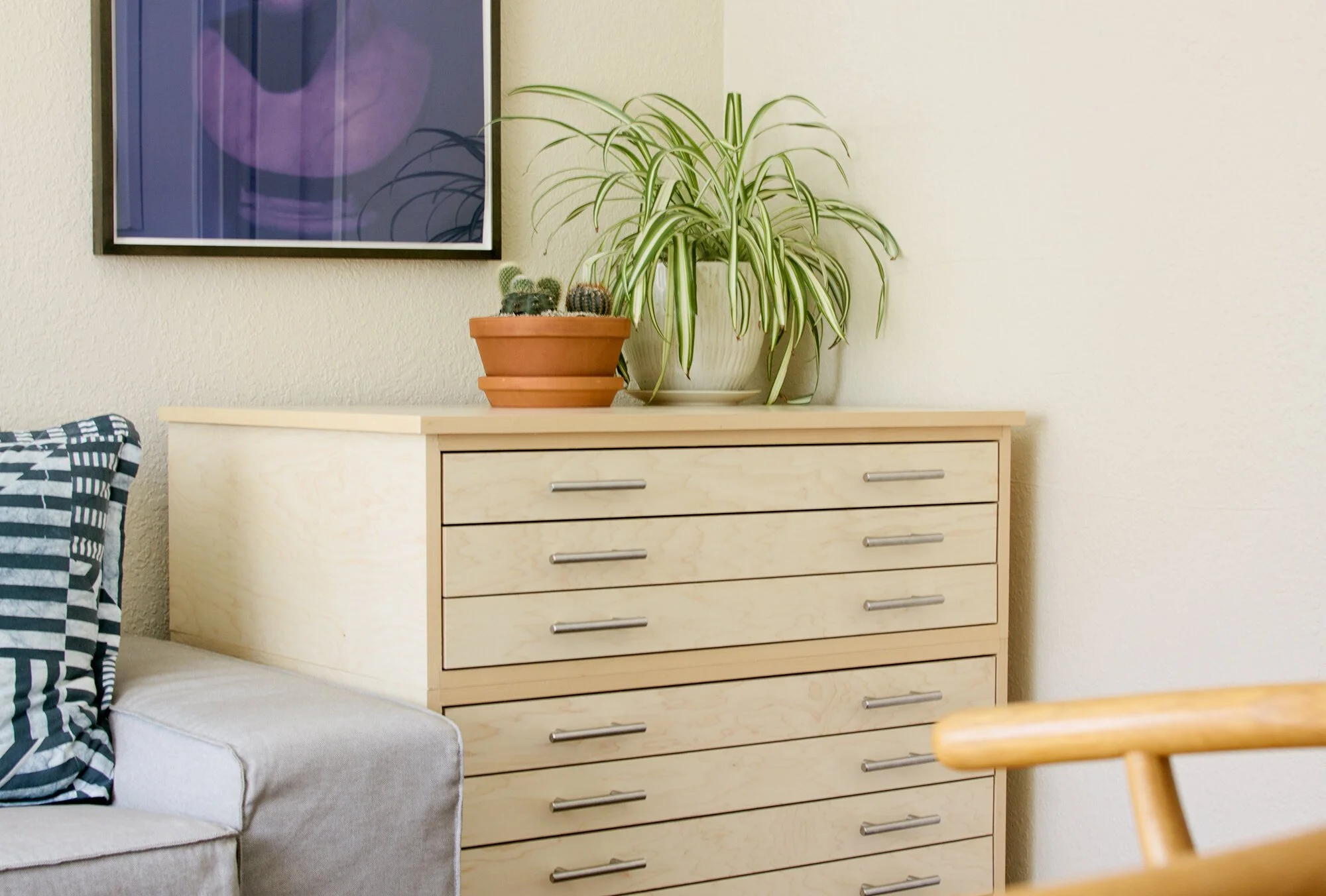04. Collecting Prints | Taking Care of your Collection
Prints are a wonderful medium to begin an art collection but as works on paper they can be more delicate and often need careful handling. To ensure they stay in good condition while they’re either being displayed or stored, there are some important best practices to keep in mind that we’re sharing below.
Framing
Float mounted vs window mounted
Float mounting is the method we always opt for when framing prints. It allows the paper to “float” in front of the back mat board and keeps the deckled edges of the paper exposed.
Window mounting is when a “window” is cut out from a sheet of mat board and placed around the printed image, covering the rest of the un-printed areas of the paper. Working with your custom framer, you can make a decision about the thickness of the mat board which in turn increases or decreases the depth of the “window”. This method of mounting is more typical for etchings or relief prints where a smaller image typically sits within a larger sheet of paper. You can learn more about the different types of methods of printing in our earlier post Know Your Printmaking Techniques from this series.
Spacers
Spacers may not be a familiar part of a frame for those who aren’t regularly custom framing pieces but if you opt for float mounting, they’re very important. They are a thin strip of material (usually archival form board) that is attached around the interior edges of the frame and keep the print from being sandwiched directly against the frame’s glazing. This creation of space is important because over time if there is direct contact, the surface of the print can be irreparably damaged or even adhere to the glazing.
Alex Jacobson from Adjective Art & Framing inserting white spacers into a frame before fitting the work.
Glazing
The clear material on the face of the frame (glass or plexiglass) is generally referred to as its “glazing”. Most plexiglass and glass products have varying degrees of UV protection or filtering that come standard but it’s always wise to double-check particularly if your home has a lot of windows and it’s likely that natural light will hit the print at various times in the day. There are premium museum-quality, low-reflection plexiglass products (Optium Acrylic® for example) that add significantly to your frame’s price but may be a wise move depending on your home’s conditions and the value of the print.
Deciding between plexiglass and glass can be a personal preference but it’s important to keep in mind your lifestyle (Where will the print hang? Will you be moving homes and want to ensure the safety of the framed pieces?) and we find plexiglass is often the wiser choice.
Both of our framing options - Standard and Premium - include the use of spacers and UV-protection plexiglass. You can learn more about the two options we offer on our framing information page.
Hanging your Prints
There are a number of considerations beyond the obvious aesthetic ones you may want to keep in mind when you’re deciding on where to hang your framed prints.
Is this a heavily trafficked area of the house where energetic small people may be in regular proximity to the piece?
Is it an area of the house that is exposed to larger levels of humidity changes? ie. kitchens or bathrooms. If so, there are ways your framer can seal the backside of the work to best prevent issues with mold and moisture.
Will direct sunlight hit the print for large parts of the day? UV-protection glazing is great but it can’t completely preserve the piece from fading over time if there is strong direct sunlight shining on the work on a regular basis.
What type of wall material do you have? Are you confident inserting drywall anchors or should you consult an expert to be sure your framed piece is securely installed?
Storing Prints
If you don’t plan to frame your print and instead would like to store it, these are some best practices.
Flat Files
We will admit that as a piece of furniture, flat files do take up a lot of space but if you’re serious about starting a collection that includes works or paper (prints, drawings, photography) this might be a good option long term.
Not all flat files are built using completely archival materials so keep in mind you may need to first stack prints in shallow boxes and then keep them in your flat files. More on boxes in the next tip.
Our Consolidated Flat File drawer set tucked away in the living room.
Archival boxes
Brooklyn-based conservation and bookbinding supply group Talas sell archival print storage boxes at various sizes that are great for the storing of prints long-term. Archival means they are acid-free and won’t cause discoloration over time.
Glassine
Also available from Talas, archival glassine is a thin, very smooth protective paper. It is wise to layer glassine between each of your pieces as it can protect delicate surfaces of prints and photographs and won’t allow for textured papers to rub up against each other insid your flat files or boxes.
Insurance
One final consideration for those who are expanding their print collection and are investing in some higher price pieces is to be sure they’re specifically added to your home and contents insurance policy. Check with your specific insurance provider.





